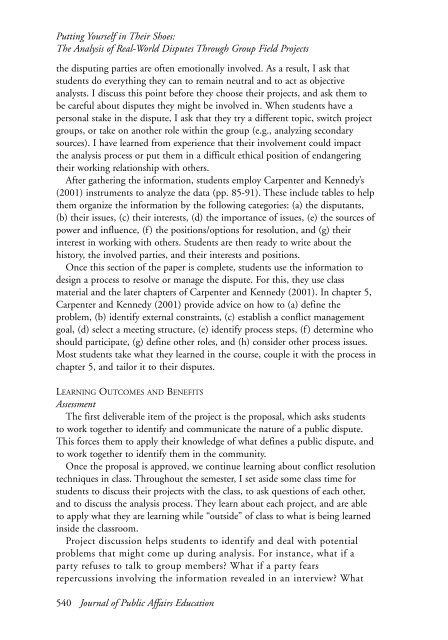JOURNAL OF PUBLIC AFFAIRS EDUCATION - National ...
JOURNAL OF PUBLIC AFFAIRS EDUCATION - National ...
JOURNAL OF PUBLIC AFFAIRS EDUCATION - National ...
Create successful ePaper yourself
Turn your PDF publications into a flip-book with our unique Google optimized e-Paper software.
Putting Yourself in Their Shoes:<br />
The Analysis of Real-World Disputes Through Group Field Projects<br />
the disputing parties are often emotionally involved. As a result, I ask that<br />
students do everything they can to remain neutral and to act as objective<br />
analysts. I discuss this point before they choose their projects, and ask them to<br />
be careful about disputes they might be involved in. When students have a<br />
personal stake in the dispute, I ask that they try a different topic, switch project<br />
groups, or take on another role within the group (e.g., analyzing secondary<br />
sources). I have learned from experience that their involvement could impact<br />
the analysis process or put them in a difficult ethical position of endangering<br />
their working relationship with others.<br />
After gathering the information, students employ Carpenter and Kennedy’s<br />
(2001) instruments to analyze the data (pp. 85-91). These include tables to help<br />
them organize the information by the following categories: (a) the disputants,<br />
(b) their issues, (c) their interests, (d) the importance of issues, (e) the sources of<br />
power and influence, (f) the positions/options for resolution, and (g) their<br />
interest in working with others. Students are then ready to write about the<br />
history, the involved parties, and their interests and positions.<br />
Once this section of the paper is complete, students use the information to<br />
design a process to resolve or manage the dispute. For this, they use class<br />
material and the later chapters of Carpenter and Kennedy (2001). In chapter 5,<br />
Carpenter and Kennedy (2001) provide advice on how to (a) define the<br />
problem, (b) identify external constraints, (c) establish a conflict management<br />
goal, (d) select a meeting structure, (e) identify process steps, (f) determine who<br />
should participate, (g) define other roles, and (h) consider other process issues.<br />
Most students take what they learned in the course, couple it with the process in<br />
chapter 5, and tailor it to their disputes.<br />
LEARNING OUTCOMES AND BENEFITS<br />
Assessment<br />
The first deliverable item of the project is the proposal, which asks students<br />
to work together to identify and communicate the nature of a public dispute.<br />
This forces them to apply their knowledge of what defines a public dispute, and<br />
to work together to identify them in the community.<br />
Once the proposal is approved, we continue learning about conflict resolution<br />
techniques in class. Throughout the semester, I set aside some class time for<br />
students to discuss their projects with the class, to ask questions of each other,<br />
and to discuss the analysis process. They learn about each project, and are able<br />
to apply what they are learning while “outside” of class to what is being learned<br />
inside the classroom.<br />
Project discussion helps students to identify and deal with potential<br />
problems that might come up during analysis. For instance, what if a<br />
party refuses to talk to group members? What if a party fears<br />
repercussions involving the information revealed in an interview? What<br />
540 Journal of Public Affairs Education

















